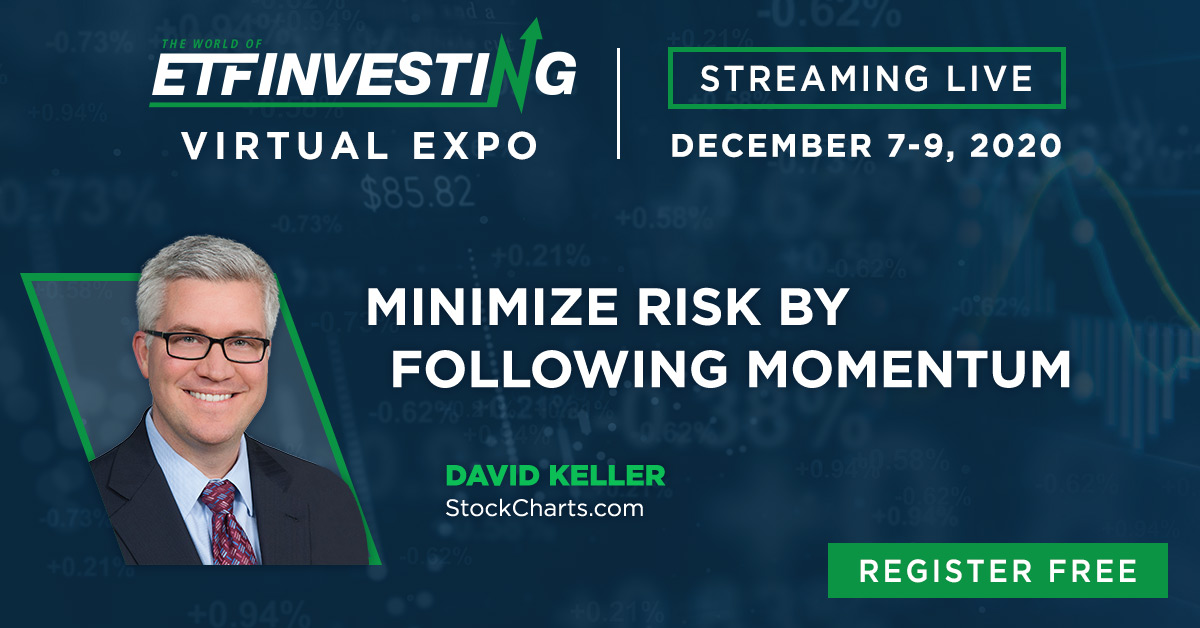| THIS WEEK'S ARTICLES |
| The Market Message |
| Amazon Weighs on Consumer Cyclicals |
| by John Murphy |
Stocks in general are undergoing some profit-taking today. And consumer cyclicals are one of the day's weakest groups. A big reason for that is today's big drop in Amazon.com (AMZN). Chart 1 shows that influential stock dropping -7% today on last evening's reported drop in first quarter earnings. And it's now testing initial chart support along its late-April lows near 2300. If that doesn't hold, more substantial support is likely along its February peak at 2185. The upper box shows its 14-day RSI line starting to weaken from overbought territory over 70. And its daily MACD lines (middle box) are in danger of turning negative for the first time since mid-March. That raises the possibility of more profit-taking to come. Because of its size, what AMZN does has a big influence on the direction of consumer cyclicals which are trading lower today.
Chart 1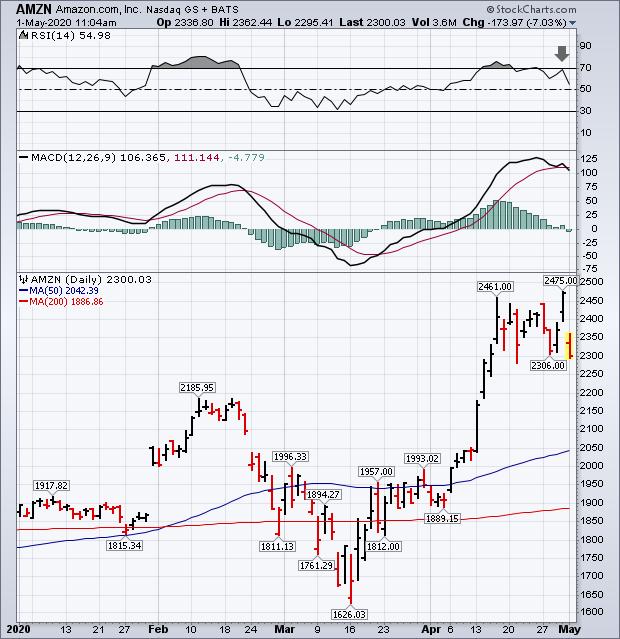
The daily bars in Chart 2 show the Consumer Discretionary Sector SPDR (XLY) pulling back sharply from its 200-day moving average. Some of its biggest losers include cruise lines, hotels, and gaming stocks which have rebounded over the past week. Today's drop in Amazon, however, is also a big reason for the pullback. That's because that stock accounts for more than quarter of the XLY weightings. So what AMZN does has a big influence on the XLY. Which today is negative.
Chart 2
Semiconductor stocks are also coming under selling pressure today. Chart 3 shows the PHLX Semiconductor iShares (SOXX) down nearly -4% today and dangerously close to falling below its 200-day line. One of its biggest losers is Lam Research (LRCX). Chart 4 shows that chip stock already falling below its 200-day average to the lowest level in nearly a month. Selling in chip stocks may also start to weigh on the tech sector and Nasdaq which are still trading above their 200-day lines. With help from some of the biggest tech stocks.
Chart 3
Chart 4
Editor's Note: This is an excerpt of an article that was originally published in John Murphy's Market Message on Friday, May 1st at 11:12am ET. Click here to read the full article, which includes Charts 5-6 and a discussion of the Nasdaq Composite Index.
|
| READ ONLINE → |
|
|
|
| Art's Charts |
| Putting the Big Bounces into Perspective |
| by Arthur Hill |

Despite a massive advance the last six weeks, the bulk of the evidence indicates that we are still in a bear market environment. The advance off the March low, while impressive on its own, still pales in comparison to the prior decline. The S&P 500 SPDR retraced around 61.8% of this decline and the Russell 2000 ETF retraced just over 50%. Such retracements are still normal for counter-trend bounces.
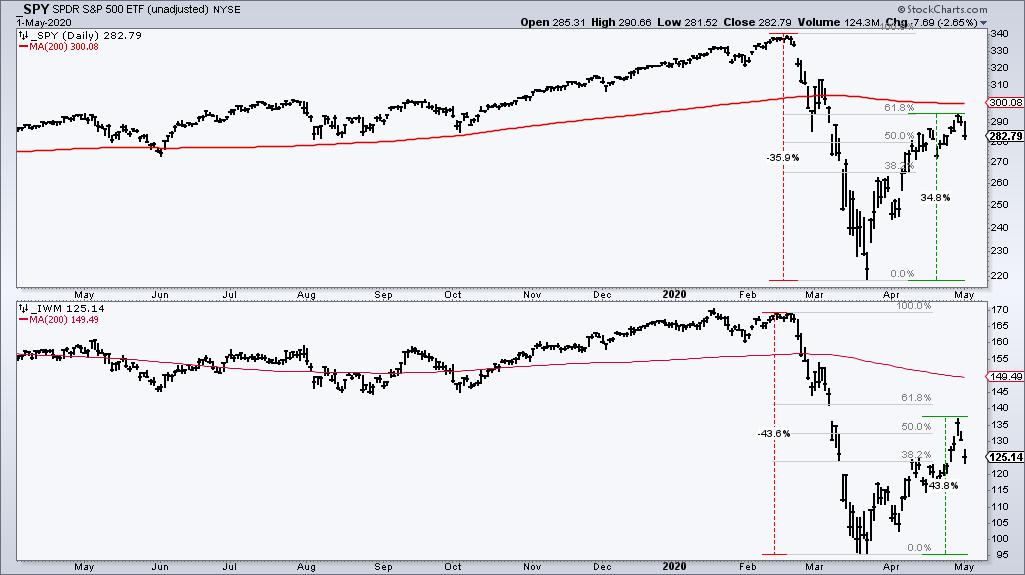
Consider the following. SPY, the S&P 500 EW ETF, the S&P MidCap 400 SPDR, the S&P SmallCap 600 SPDR and the Russell 2000 ETF are all below their falling 200-day SMAs. Nine of the eleven sector SPDRs are also below their 200-day SMAs. The Nasdaq 100 ETF, Technology SPDR and Healthcare SPDR are above their 200-day SMAs and leading, but they cannot do it alone. Moreover, not one index or sector recorded a 52-week high this month.
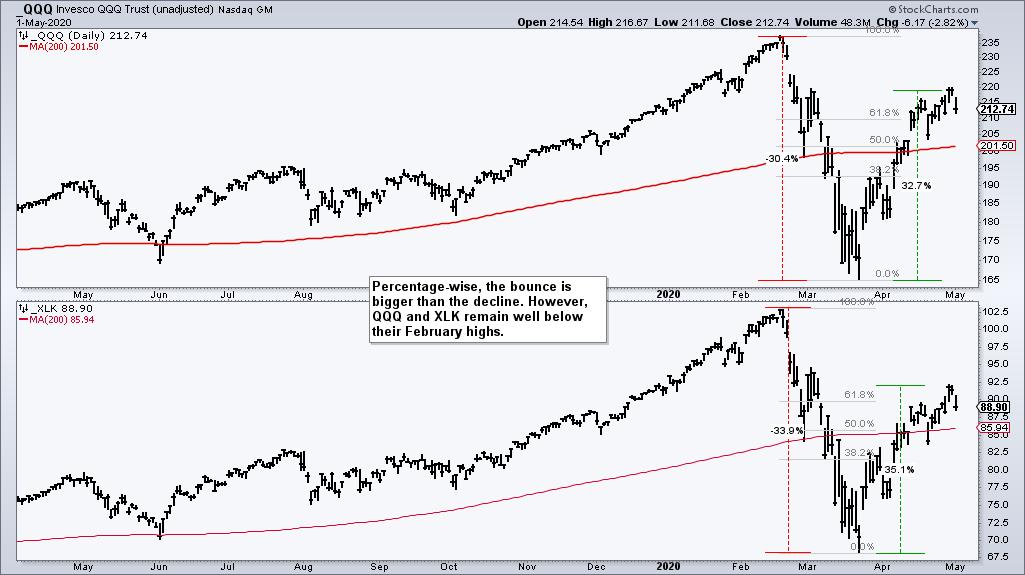
Overall, most bounces retraced a normal amount, most equity-related ETFs are still below their falling 200-day SMAs and not one index or sector ETF hit a new high. This is not the stuff of bull markets. There were improvements in the breadth models at TrendInvestorPro.com, but the key long-term indicators are not even close to triggering. In addition, our ranking of the core ETF list still shows stock alternatives leading the pack (bonds, gold, gold miners). Click here for sign up and get immediate access.
Click here to take your analysis to the next level!
---------------------------
|
| READ ONLINE → |
|
|
|
| The Canadian Technician |
| Big Cap Tech Earnings Are Out |
| by Greg Schnell |
It seems odd that the best company in the COVID-19 backdrop gets crushed after earnings. AMZN is down $200 after their earnings announcement. It is still a great company, but that is a vicious reversal. Currently, it is giving back 40% of the breakout.

As I am continually amazed by the strength of the bear market rally, its purpose is to get everyone flipped to bullish while within the downtrend. If it is not a bear market rally, but the start of the next bull market, those who traded this off the lows will have done very well. Others will just be getting onboard as it starts to look like the bull is back in play.
There are some friction points on the $SPX and I want to discuss those. The two key resistance points are starting to come into play. While there are many who are keen Fibonacci retracement followers, I am not that active using fib's. I have been expecting the lower level (50%) to be the retracement levels to watch out for. While the market kept pushing higher, the $SPX has tagged the 61.8% retracement and we are seeing a quick decline. The second major hurdle is the 200 DMA just above at the 3000 level. Now that the 200-day moving average is down-sloping, this is a very important resistance. Both of these are so close together as to make it a strong resistance level.
With the accelerating volume recently (three days), it does make you wonder what changed. It might appear the big boys are starting to reposition for the downside and selling into the rally as the tech names reported.
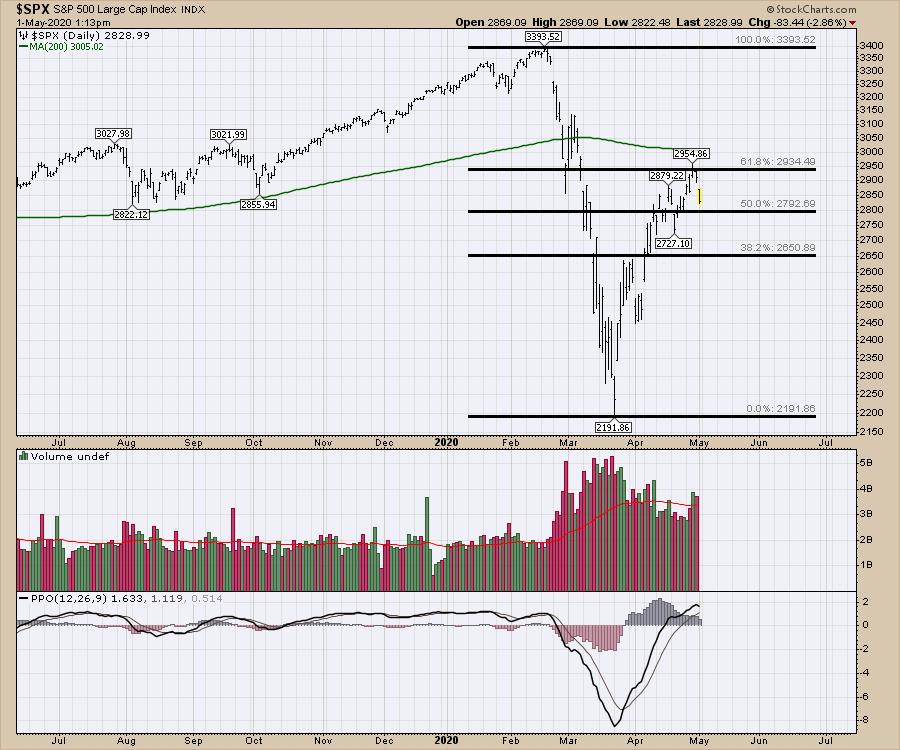
We have great examples from the big pullbacks in the 2000-2003 and 2007-2009 bear markets. The 200-day moving averages are shown in green. In the 2000-2003 pullback, the 200-day moving average was an important level of resistance to be aware of. In late 2001-early 2002, there were three occasions where you would be wondering if the market was going on to higher highs. Two of those were off the original 9/11 drop. But notice the intensity of the bear moves. They rarely paused to give you time to reassess the situation. They will trade wildly, with vicious volatility, when trapped below the 200-DMA. I have not drawn a line, but notice the 1400 level, which was the lower 1/3 of the price action through most of 2000. The 1438 high, as well as the 1383 high, were tests of that range and coincided with the 200-DMA close by.
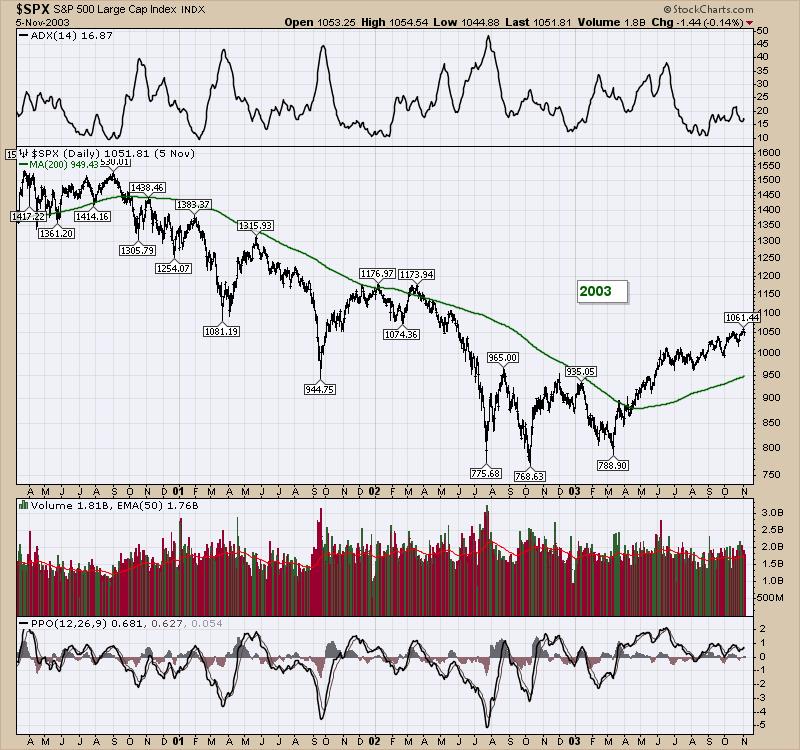
Below is the picture for 2007-2009. The 200-DMA was a good resistance line for many months. Notice the difficulty in 2009 as it finally cleared it, but walked lower with it for a full month before reversing to the upside.
Once again, notice the 1400 level. It was a support resistance line of the action in 2007, but still ended up being a textbook place to expect price to fail when price met the 200-DMA there in May 2008. The May to July 2008 move was particularly harsh, with lots of overlapping price action, but walking lower.
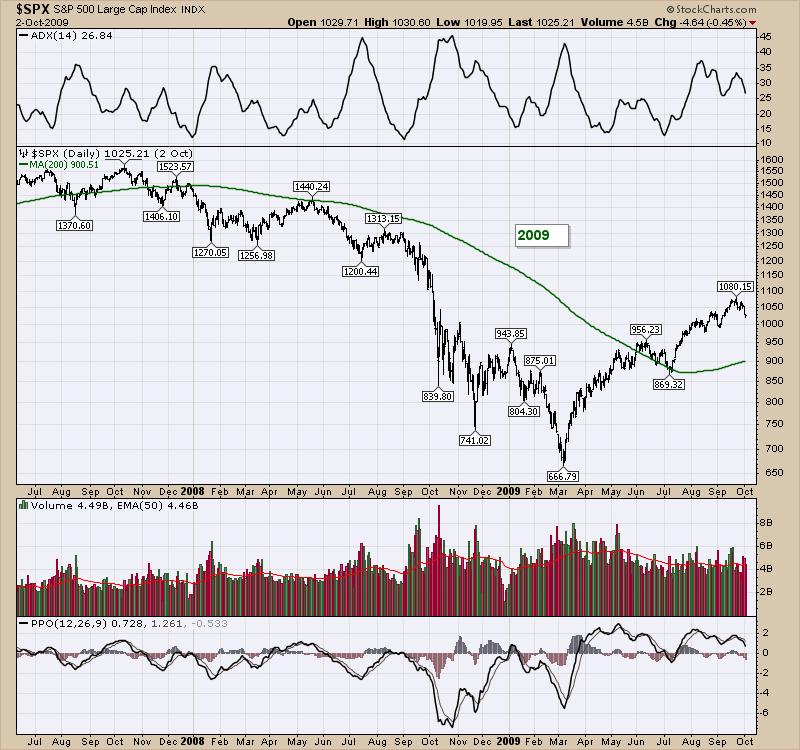
Now we have reached the 200-DMA again on the 2020 chart shown below. The friction levels of 2950 and 2800 are important levels to focus on now, due to the similar pattern in the 2019 price action to that which we saw in 2000 and 2007 above.
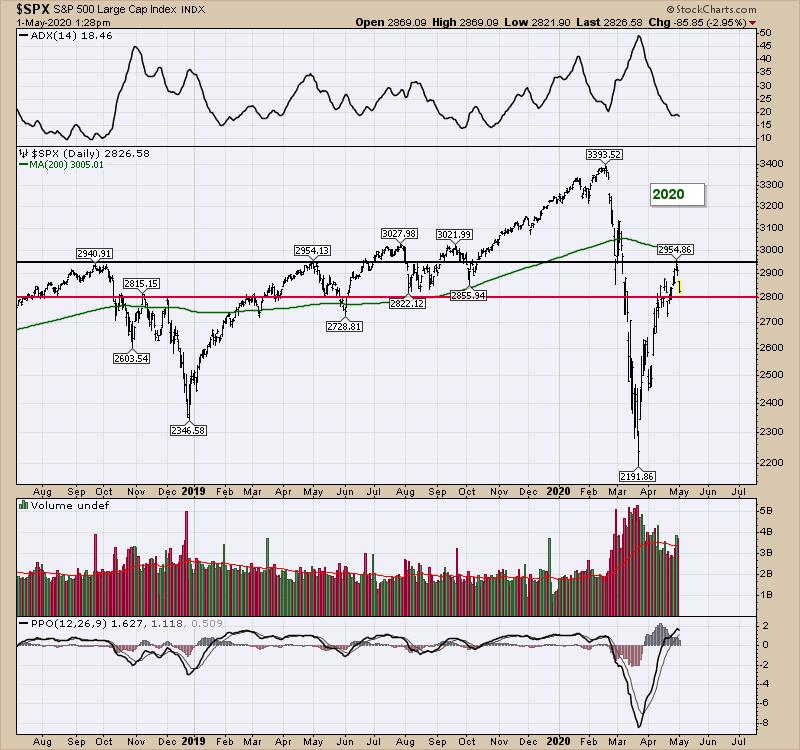
If 2800 fails to hold, it will be a rocky walk south until some support starts to show up. For me, it means either trade carefully or, alternatively, sit back and let others, namely institutions, find the base.
|
| READ ONLINE → |
|
|
|
| The Traders Journal |
| Pro Sports Drafts: 7 Essential Lessons Investors Should Learn From The NFL, NBA, MLB and NHL |
| by Gatis Roze |
 In a recent survey of serious investors, it was uncovered that a majority are earnest sports fans. Count me guilty. As I write this, we just completed the National Football League's (NFL) draft. But the focus here is not on simply one sport. All the major pro sports leagues hold player drafts. There are uncanny parallels between what's required to be a consistently profitable investor and what's involved in successful drafts executed by winning pro sports franchises. In a recent survey of serious investors, it was uncovered that a majority are earnest sports fans. Count me guilty. As I write this, we just completed the National Football League's (NFL) draft. But the focus here is not on simply one sport. All the major pro sports leagues hold player drafts. There are uncanny parallels between what's required to be a consistently profitable investor and what's involved in successful drafts executed by winning pro sports franchises.
I realize that it may seem like an odd time to be discussing pro sports since teams in all sports are in shut-down mode, but if you'd like to invest like a Super Bowl winner, read on. The parallels are both apropos and powerful and will make you a better investor.
THE BIG PICTURE
Pro sports franchises have entire departments of experts dedicated year-round to preparing for ‘The Draft.' Each team has a long term vision that differentiates itself from the competition with the objective and expectation of winning. It's a unique culture. Some teams call it their "program" but whatever the label, it's that team's own secret sauce.
I'm a season ticket holder for the new NHL/Seattle franchise that's slated to start in 2021. I was recently invited to a panel discussion with the team's five talent scouts. It was entertaining but not enlightening because their "formula" is highly proprietary and prudently protected. Much like Wall Street's market wizards who don't divulge too much about their respective methodologies. It makes perfect sense. Their recipes provide the unshakeable foundations that they must believe in with conviction in order to trade and draft players effectively. They'll be candid with outsiders, but only up to a point.
The key takeaway is that both parties — sports franchises and investors — have well-defined long term goals and visions. Being prepared and putting in the work upfront is what yields successful results in both camps. Hopefully, it also bestows the power of patience upon the participants. A requisite attribute if one is to succeed. Having an unshakeable game plan allows you to utilize your intuition and confidence in that you know what your end objectives truly are. Without this, you're merely a feather tossed about randomly by the wind. Jesse Livermore always claimed it was sitting (i.e. patience) that made him millions.
BALANCE
In sports, we could discuss the merits of defense versus offense ad nauseam, but we can all agree that you need them both. Hypothetically, if a team has the first five draft picks, it could corner the market — picking the five best quarterbacks, for example. However, the probability of that team achieving a winning season is zero because even the best quarterback needs someone to throw to and a solid line of protection. The same holds true in investing. Yes, there are a few ‘plungers' in the stock market who go heavy into a few unique equities, but none that I'm aware of who've achieved consistent long term success or even survival. Balance wins.
Watching the strategic choices made by respective teams during the draft, it's clear that balance is a sacred mantra amongst all franchises. As investors, we also need to hold a regular draft and rebalance our portfolios. Balanced diversification amongst key asset classes is similarly a time-tested investing mantra. Don't draft five quarterbacks.
THINK GLOBAL
There are over 100 foreign-born basketball players in the NBA and it's stronger with them. As investors, our portfolios should also have some foreign-born equities. We profit by drafting the right international equities. Don't be just USA-centric.
FAST & FURIOUS
To borrow a movie franchise handle which is particularly appropriate in both pro sports and investing. During a draft, time is of the essence since you're on the clock. It's similar to stacked plexiglass chess boards with multiple games being played simultaneously. The puzzle pieces are constantly moving — dominos are falling as shifting consequences ripple through each round. The indispensable tools needed: contingency plans, quick flexible thinking, and action-oriented reflexes.
Isn't the stock market a similar daily draft of equities? It's an auction market between buyers and sellers, with both bullish and bearish scenarios of shifting dollars with rippling consequences all around. Investors must embrace similar tools and attributes. As I like to remind investors, you may choose to ignore the market but it will not ignore you. Stay engaged!
SPEAK THE LANGUAGE
If you want to play in the sandbox, learn the jargon. Without that knowledge, you're like an accountant at an engineering firm. Accurate and precise communication matters.
Sports franchises have draft jargon on two fronts. There's the financial jargon such as dollar cap hit, soft cap, hard cap, dead money, back heavy, etc. Then there's the sports language to describe players themselves. That jargon is unique to the different positions played. Amazing. It's the same in the investor sandbox. If you don't understand bid-ask spreads, the difference between limit and market orders, or ex-dividend dates, you'll cost yourself real dollars.
PERISHABLE ASSETS
Have any friends who own restaurants? They'll tell you the hardest part of the business is that their assets are perishable. I don't mean to seem heartless, but pro sports is a business, and players are also a perishable asset. Their value to the team vacillates, and just like with stocks, you can actually chart it. That's what the teams's analytics department does. All players are rated and ranked, constantly evaluated and re-evaluated. They're weighted and not just by their statistics. Stocks are valued by their earnings. Top players are consistent with high sports IQs. Top stocks pay dividends and grow earnings. Lower ranked players behave badly or get injured. Lower ranked stocks produce negative earnings surprises or face litigation issues.
The takeaway is simple. All assets begin to fade and diminish in value over time. When do you cut your losses and exit? Even the best players need to retire at some point. Even once great companies stumble and fall — like PG&E, Worldcom and General Electric. Some go bankrupt. Sorry, but they're perishable and that's just reality.
SEPARATE THEATER FROM REALITY
Emotional control is easy to verbalize and discuss rationally but when the adrenaline starts pumping and the talking heads start preaching, the emotional commotion begins. It's theater — pure and simple. The pressure builds to draft player A over draft player B, to buy sexy stock C or dump stock D. Your job is to separate the theater from the reality.
You must stay true to thyself. Stick to your investment roadmap. Follow your game plan. Control your emotions. Don't get swept up in the inevitable swings to the extremes of over-valuation and under-valuation. As is true with so much in the investment arena — get your ego out of the way. Be humble or you'll fumble!
The market's always right, and the charts don't lie.
Trade well; trade with discipline!
- Gatis Roze, MBA, CMT
StockMarketMastery.com
|
| READ ONLINE → |
|
|
|
| DecisionPoint |
| Swenlin Trading Oscillators Gave Warning... Again! |
| by Erin Swenlin |
Yet again, the Swenlin Trading Oscillators gave our readers early warning for today's decline. I have written about their previous successes in ChartWatchers, but I wanted to report back to you that they are continuing to be leading indicators. Below is an excerpt from yesterday's DecisionPoint Alert with updated charts and added new commentary in italics:
Short-Term Market Indicators: The ST trend is UP and the market condition is OVERBOUGHT based upon the Swenlin Trading Oscillator (STO) readings. The STOs topped today, which generally is the main ingredient in the recipe for a short-term decline. How much of a decline? I believe worst case is the 270 level on the SPY. I've updated the chart to include today's action. We now have a breakdown from the bearish rising wedge. You can see that the %stocks > 20/50-EMAs had also begun to deteriorate before the market. I still am looking for support to hold at 270 for the SPY.
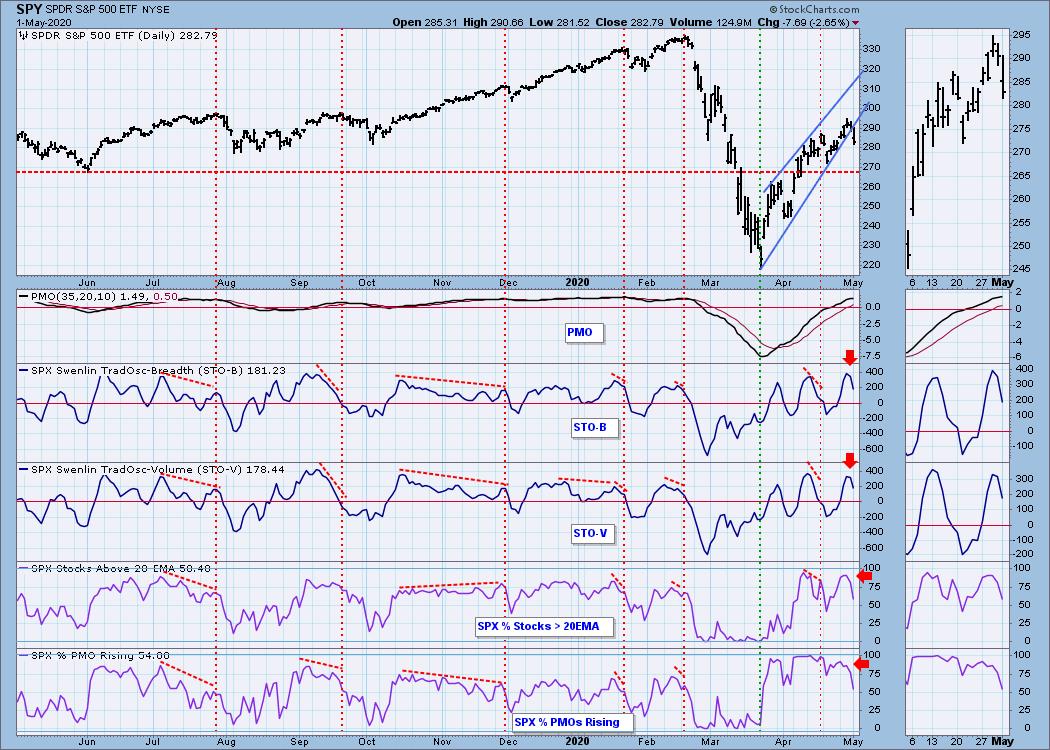

As investors, we want to accomplish two basic things: (1) Determine the trend and condition of the market and (2) select stocks that will ride that tide. The DecisionPoint Alert helps with the first step, and DecisionPoint Diamonds helps with the second. Go to DecisionPoint.com and SUBSCRIBE TODAY! (Charter Subscriber Discounts Available!)
Climactic Market Indicators: Today, we saw negative climactic readings. Combine these with the VIX and I have to say we are looking at a selling initiation. We should expect lower prices going into tomorrow. These indicators had even more climactic negative readings today, which suggests further decline.
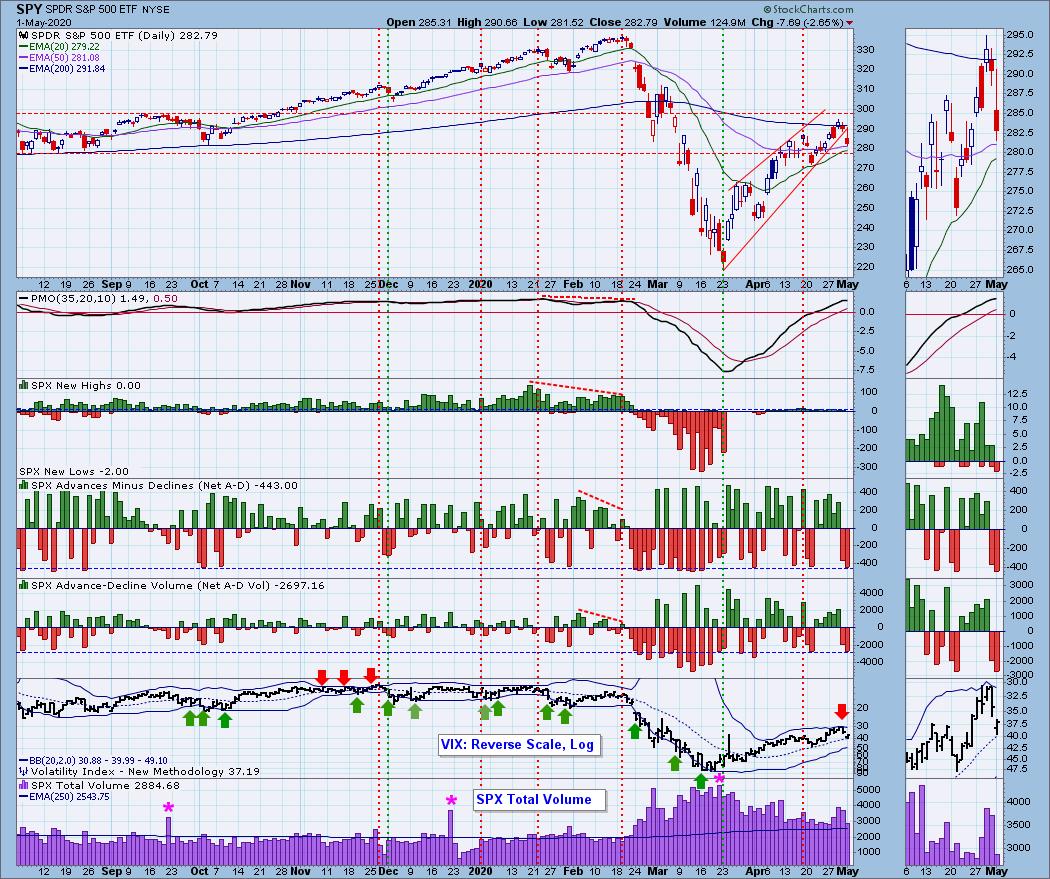
Live Trading Room - Tuesdays/Thursdays
I'm teaming up with Mary Ellen McGonagle (MEMInvestmentResearch.com) to do regular "LIVE Trading Room" sessions for FREE at 11:00am ET. We've had excellent reviews on our new LIVE Trading Rooms so far and plan on continuing them Tuesdays/Thursdays 11:00am ET. The link will be sent out the day before the event, so watch your email and tell your colleagues to sign up for our free email list on DecisionPoint.com to be notified!
Conclusion: I'm finding our indicators exceedingly helpful, especially when paired with the DecisionPoint Analysis Process. To finish off today's article, I'll give you my "Diamond" of the week from the DP Diamonds Report. I present 60 stocks each month for just $25! While they are "diamonds in the rough" and provide no guarantee of success, I've been culling from the Diamonds Reports for my own investments and have had success through this tough time.
If you'd like a trial to our website newsletters, contact support@decisionpoint.com and we will hook you up!
Happy Charting! - Erin
Diamond of the Week (from Monday 4/27 DP Diamonds Report):
Below are the original article and charts. Underneath each chart, I've included the updated chart for today.
AdvanSix Inc (ASIX) - Earnings: 5/1/2020 (BMO)
The double-bottom pattern never executed, but this actually has set-up a possible triple-bottom. This one reports earnings on Friday and, with a near 11% move to the upside, it may require some patience. Setting a stop is a bit tricky in terms of finding support, so I just listed an 11% stop area based on today's move. The RSI isn't quite in positive territory above 50, but it is trending higher. The OBV bottoms are very positive given comparative price bottoms are mostly flat.
Chart from 4/27:
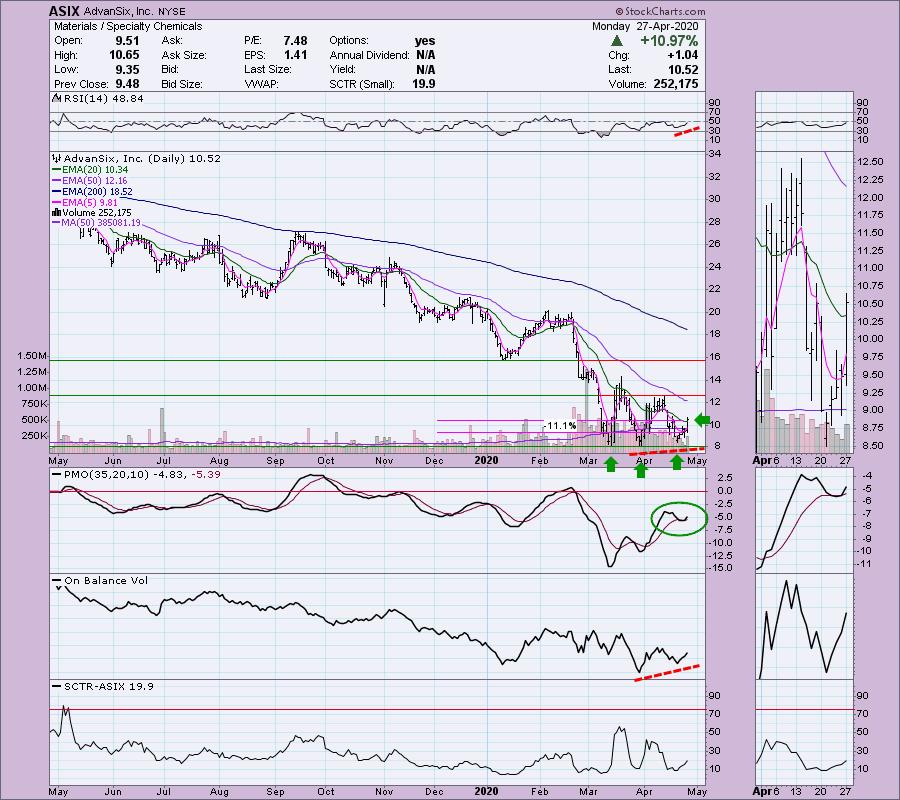
Daily Chart from Friday 5/1:
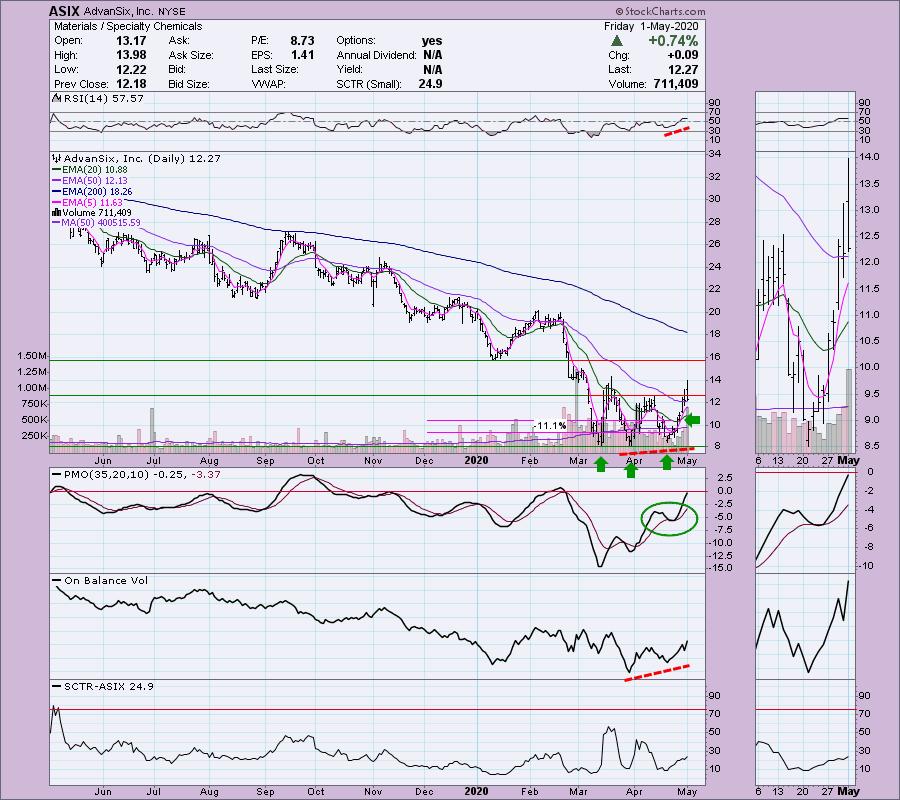
While upside potential is amazing here, the stock is trading below its IPO. That could be stiff overhead resistance. The weekly PMO is turning up (although I note it did the same thing in late March on the failed rally). Just be careful here, I recommend position sizing to protect yourself.
Weekly chart from 4/27:
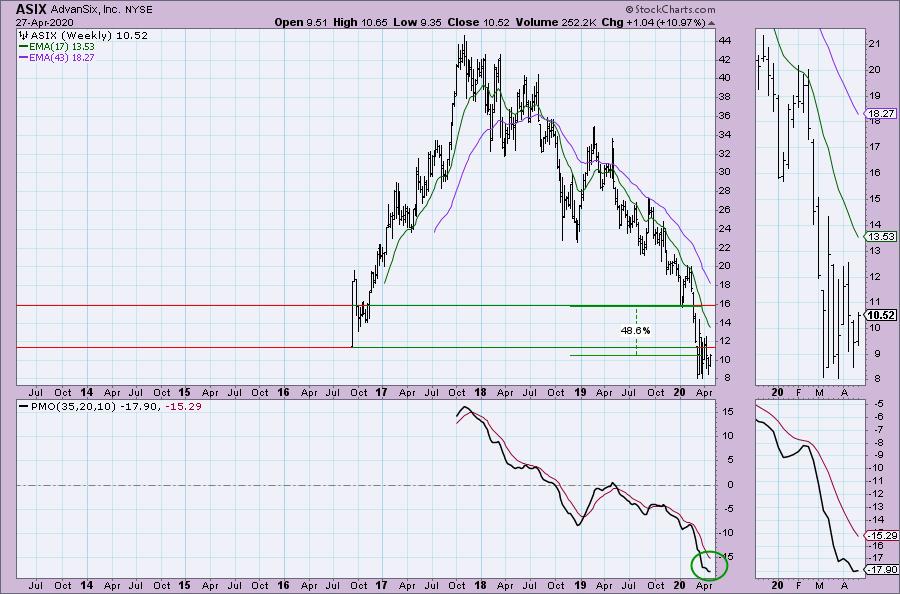
Weekly chart from Friday (5/1):
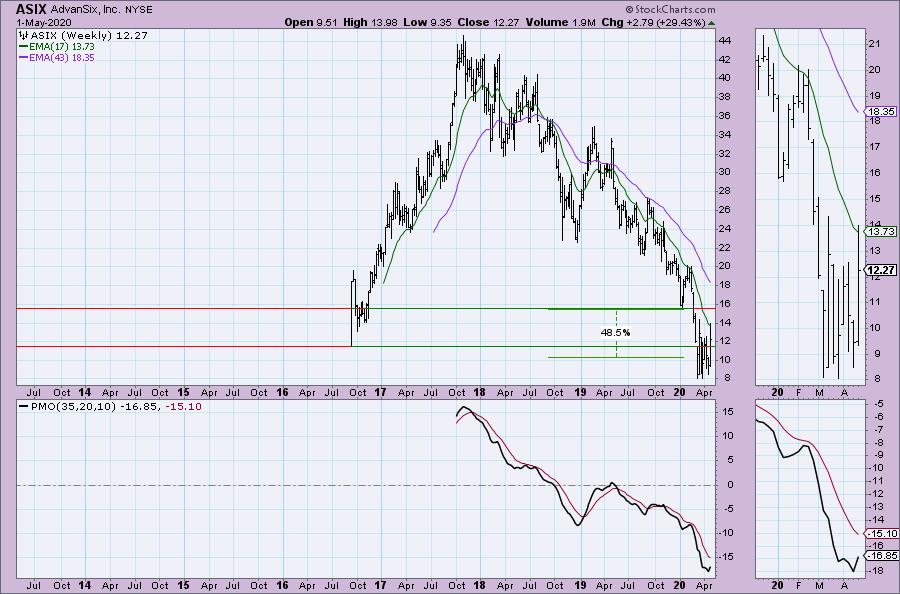
Technical Analysis is a windsock, not a crystal ball.
Helpful DecisionPoint Links:
DecisionPoint Alert Chart List
DecisionPoint Golden Cross/Silver Cross Index Chart List
DecisionPoint Sector Chart List
DecisionPoint Chart Gallery
Trend Models
Price Momentum Oscillator (PMO)
On Balance Volume
Swenlin Trading Oscillators (STO-B and STO-V)
ITBM and ITVM
SCTR Ranking
|
| READ ONLINE → |
|
|
|
|
|
| ChartWatchers |
| Don't Let the Disconnect Between Wall Street and Main Street Derail You |
| by John Hopkins |
Last Wednesday, the NASDAQ got within just a few very strong sessions of reaching its all-time high. Let me repeat; it's All-Time High! Notwithstanding the much-needed pullback on Friday, how is this even possible, with millions of people out of work, most of America shut down and most people staying at home due to the coronavirus? It's a very good question, but a question that might not even matter if you're focused squarely on the stock market.
In order to grasp what is happening, and particularly why the market is benefiting, you have to almost ignore all of the reasons you could come up with as to why the market should be much lower. And you also need to grasp the enormity of the stimulus the Fed is throwing at the economy, from the billions in direct payments to individuals, to the billions going to small businesses to help them meet payroll, to the billions going to those industries in big trouble, like the airlines, and are on the brink of going out of business. They're backing corporate bonds while making sure all types of market-related assets remain liquid. And you also have to consider what Fed Chairman Jerome Powell said when he made his post-interest rate decision comments last Wednesday, which included making it crystal clear that the Fed will do WHATEVER IS NECESSARY to get us through the current and unfortunate situation. In other words, a blank check.
Now, there are a lot of analysts, gurus and even ordinary folks (like me) who are skeptical, wondering how in the world we're going to pay for all of this. And the answer is? We'll deal with it later, which seems unsatisfying, but that's the current reality.
I do want to point out - which many of you already know - that interest rates are at historical lows. In fact, look at the chart below on the 10-year Treasury Note:
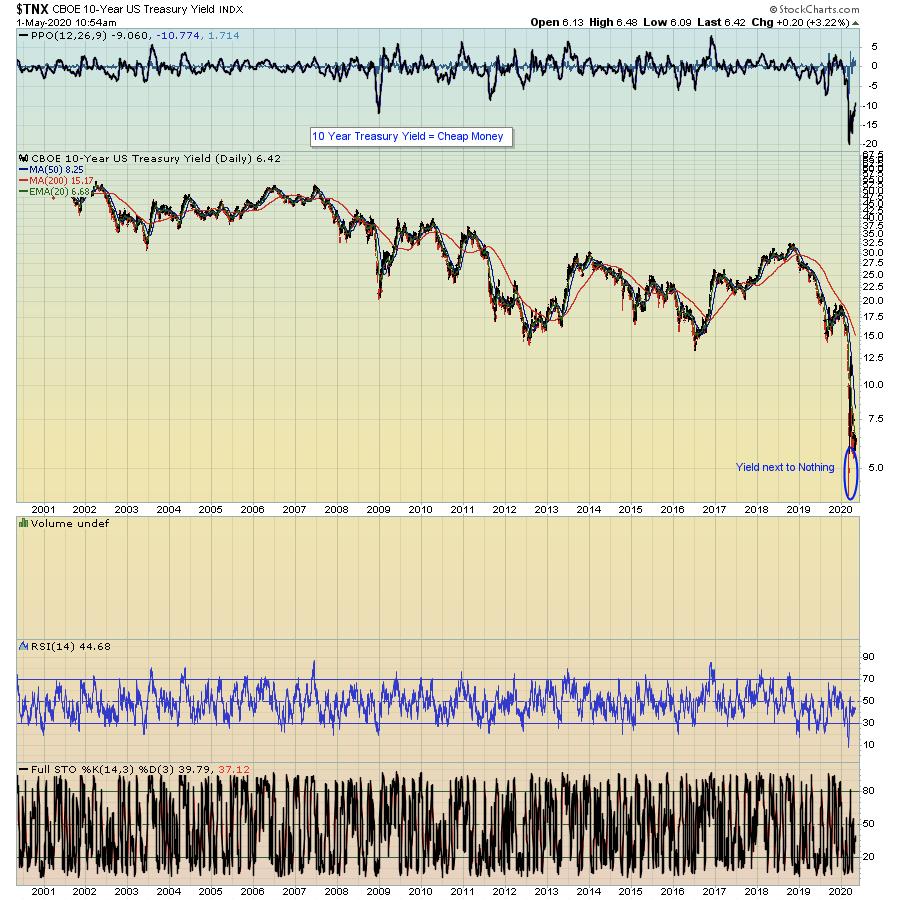
You can see that the yield on the 10-year Note is currently near 60 basis points. And it dipped below 40 basis points at its recent low. That's pretty close to yielding zero. But it does point out that money is as cheap as it's ever been. And who benefits from that? Certainly companies that might need to borrow - and there are plenty of those now - and who can leverage those cheap funds to either survive or fuel greater growth.
You might also have noticed that the giants of the market, including companies like Apple (AAPL), Amazon (AMZN), Facebook (FB), Microsoft (MSFT) and NVIDIA (NVDA) have held up just fine. Why? Because they have a ton of cash, don't have to worry about the day-to-day issues that most have to and have found the coronavirus-induced stay-at-home environment suits them just fine.
In fact, at EarningsBeats.com, we have adjusted our strategy to try to take advantage of those industries and stocks that have fared the best in spite of everything spiraling around us. And it's worked out quite well, as we have turned our attention to those stocks that have the strongest Accumulation/Distribution charts. And many of those stocks come from our Strong Earnings ChartList that we are making available to anyone who subscribes to our FREE EarningsBeats Digest, which comes out every M, W and F and focuses on earnings-related topics. So if you are currently NOT an EarningsBeats Digest member, just click here to sign up and we will make sure you get a copy of our Strong Earnings ChartList. In the meantime, try to stay focused on the market action while remembering the Fed is using, and will continue to use, all of its available tools to guide us through this difficult time. In other words, Don't Fight the Fed!
At your service,
John Hopkins EarningsBeats.com
|
| READ ONLINE → |
|
|
|
|
|
| MORE ARTICLES → |
|













 In a recent survey of serious investors, it was uncovered that a majority are earnest sports fans. Count me guilty. As I write this, we just completed the National Football League's (NFL) draft. But the focus here is not on simply one sport. All the major pro sports leagues hold player drafts. There are uncanny parallels between what's required to be a consistently profitable investor and what's involved in successful drafts executed by winning pro sports franchises.
In a recent survey of serious investors, it was uncovered that a majority are earnest sports fans. Count me guilty. As I write this, we just completed the National Football League's (NFL) draft. But the focus here is not on simply one sport. All the major pro sports leagues hold player drafts. There are uncanny parallels between what's required to be a consistently profitable investor and what's involved in successful drafts executed by winning pro sports franchises.









